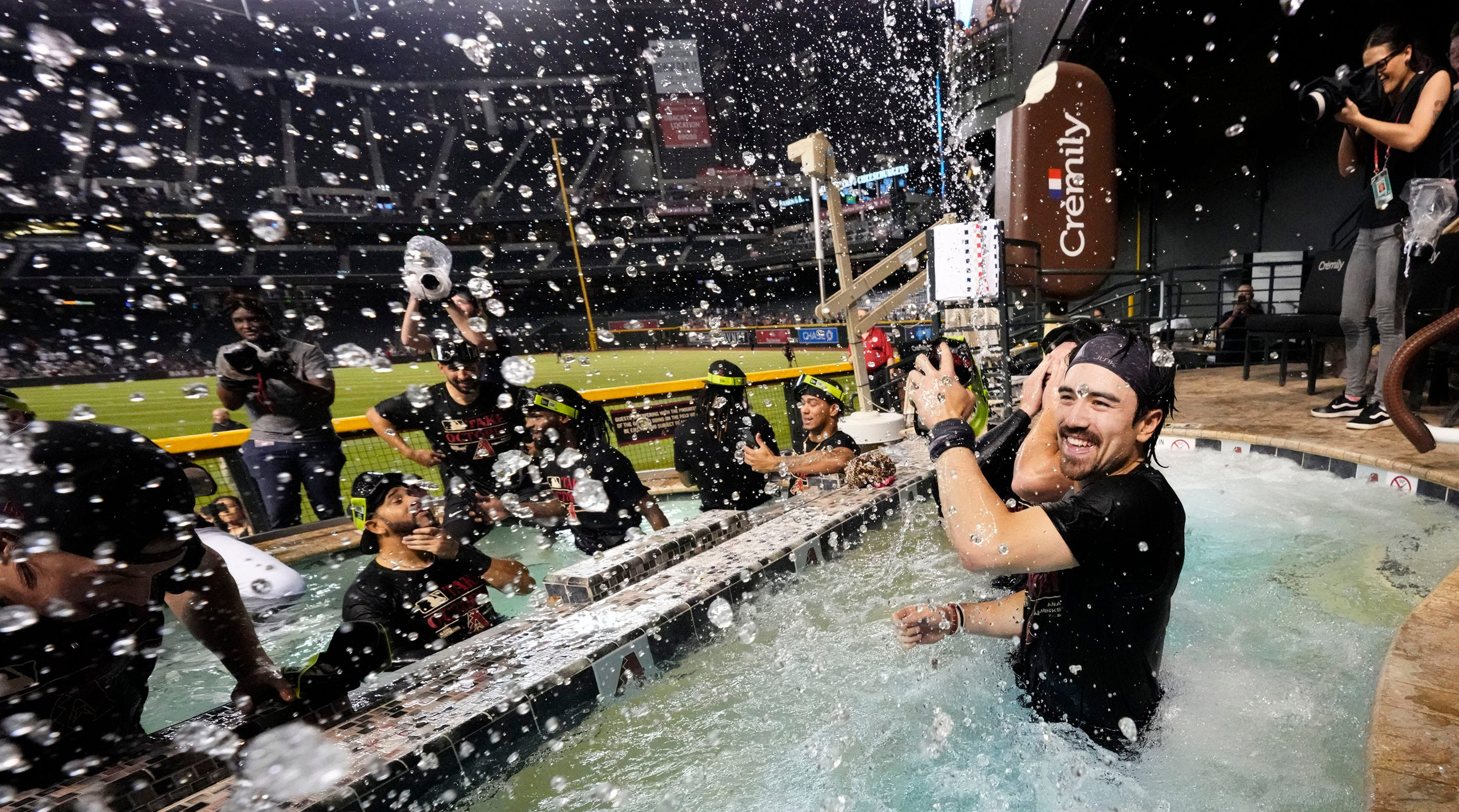The Splashy Origins of the Diamondbacks’ Pool at Chase Field

PHOENIX — In 1992, with construction finishing up on a new arena for the Phoenix Suns, team owner Jerry Colangelo gave a tour of the building to Buzz Ghiz.
Ghiz’s family business was the largest pool builder and retailer in Phoenix. Colangelo was trying to woo him as a team sponsor. But looking around the unfinished arena, Ghiz had another thought.
You know what could be really great here? he told Colangelo. A pool. A 25-meter pool right under the hardwood so you could host swim meets.
That wasn’t in the cards. The building now known as Footprint Center has seen basketball, hockey, concerts and indoor football, yet it never did get a pool. But the two men kept in touch. A few years later, Colangelo became part of a group that won an MLB expansion team. And he soon decided that meant he needed someone to build a pool.
“I got a call out of the wild blue,” Ghiz says. “He said, ‘Now I’m one of the owners of the Arizona Diamondbacks, we’re building a new stadium, and you know what, I want to put a pool in the outfield.’ It kind of just brought it all back from when I’d talked about it at the Suns’ arena.”
Watch the Diamondbacks with Fubo. Start your free trial today.

Colangelo’s group had been inspired by the outfield shower former White Sox owner Bill Veeck installed at Comiskey Park in the 1970s. A pool had never been done before, however, and it was a much bigger statement than a shower. Ghiz went to work. His creation in right field is now one of the most recognizable symbols of the Diamondbacks.
The pool has been a splashy landing spot for home runs since Chase Field opened in 1998. It’s become the obvious choice for any celebration at the ballpark—players and executives and team staff alike cannonballing into the water to commemorate a clinch. (That has applied both to the Diamondbacks themselves and to visiting opponents.) It’s inspired similar pools at venues in Miami and Jacksonville. The last time the Diamondbacks were in the World Series, in 2001, Sports Illustrated even had columnist Rick Reilly cover Game 6 from the water. (While the Diamondbacks did win the series at home—in dramatic fashion—they didn’t mark the occasion with a dip in the pool. It would be another decade before the team started the tradition of celebrating playoff series wins by diving in.) There are other ballparks with a strong sense of place. There is perhaps none with a feature as practically and culturally symbolic of its location as the pool in Phoenix. It’s been criticized by traditionalists. But it’s fiercely loved by fans. And, naturally, by any celebrating players with a chance to jump in.
The Diamondbacks’ season is on the brink after a bullpen game spun out of control against the Rangers on Tuesday. They now face a 3–1 deficit in the World Series. No matter what, Wednesday will be their final home game of the season, with Arizona set to go on the road for a potential Game 6 and 7. Which means it hopes the pool has already seen its last celebration of the year. The easiest way to ensure that, of course, is for the D-Backs to win Game 5. But the team has previously gone to other great lengths to guarantee an opponent won’t take a triumphant dip.
Ghiz says he never imagined that players might celebrate in the pool like this. “I thought the fans would get a great kick out of it when a home run ball hit the pool,” he says. “But I’m not sure I’d thought it would ever be players jumping in the pool.” His focus while building it was instead on the fan experience. This is the reason for the pool, after all: It’s a place to watch the game. That was important to Ghiz during the design stage. The pool had to feel like a central part of the park—close to the action—rather than a far-flung attraction buried on the concourse.
“It was all designed strategically for good viewing and good pleasure,” says Ghiz, who sold his pool company years ago and is now semi-retired.
Much like a suite, Arizona’s pool can be rented on game days by groups of up to 35 people. The chance to watch a game there at this time of year doesn’t come cheap. (The World Series price tag: $26,000, per the Arizona Republic, with tickets, parking passes and 35 D-Backs pool towels included. That’s more than five times the starting price for the regular season.) A lifeguard is on duty, and the pool is joined by a hot tub, which is elevated a few feet above the pool and offers a clearer view as a result.
Diamondbacks fans did not have much to cheer about in Game 4: Arizona was down 10-0 by the third inning. But when the team began to rally toward the end of the game, with six runs in the final two frames, there was one crowd reaction to merit inclusion on the broadcast.
CANNONBALL! 🤣 #WorldSeries pic.twitter.com/8RizFeUQWs
— MLB (@MLB) November 1, 2023
Of course: It was a jump in the pool. Diamondbacks fans can only hope for more to keep them swimming in Game 5.
